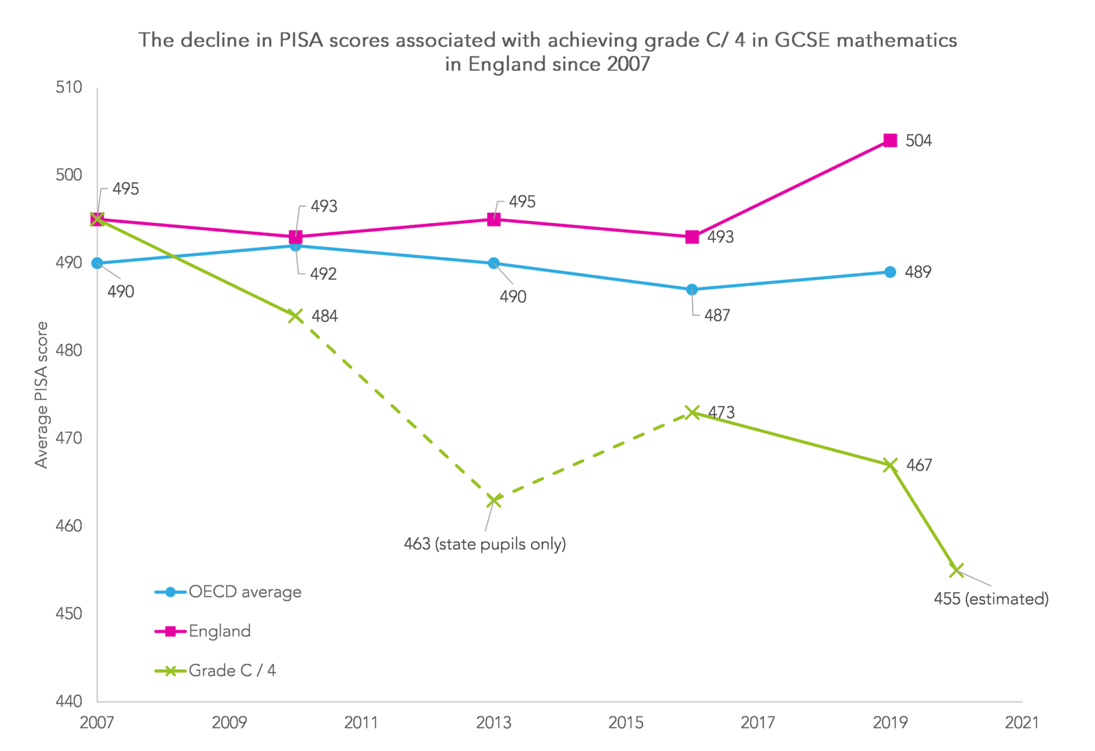There has been a “clear and sustained fall” in the value of England’s standard GCSE pass at grade C or 4 over time, research has concluded, equating to a whole year’s worth of schooling.
In an FFT Education Datalab blog published today, Professor John Jerrim of UCL’s Institute of Education compared the average Programme for International Student Assessment (Pisa) scores over time achieved by pupils in England who scored a 4/C “standard pass” grade in GCSE mathematics.
GCSEs 2021: ‘Excessive grade inflation’ warning
Exclusive: GCSEs 2021 ‘Weimar’ grade inflation warning
Background: New GCSE ‘pass’ lowered from grade 5 to 4 in DfE U-turn
He found a sustained fall in the value of a standard pass. In 2007, achieving a grade C in maths was equivalent to the OECD average of 495 points.
“Yet this value has got gradually eroded away, down to around 470 after Michael Gove’s time in charge and down to around 455 points for a grade 4 in 2020,” Professor Jerrim said.
“To put this into context, the OECD would equate this 40-point fall in the value of England’s floor target between 2007 and 2020 to a drop of more than one whole year of schooling,” he added.

When the value of a C grade in 2007 is ranked with the 2018 Pisa mathematics results, it scores 495 OECD points, while a grade 5 in 2019 scores 506 points.

Professor Jerrim said this showed that students who got a grade 4 in mathematics in 2020 had roughly the same skills as the average young person in countries like Turkey and Ukraine, around 16 places lower in the Pisa rankings than a child who got a C grade back in 2007 (roughly equivalent to countries like Australia, New Zealand and France).
“The table also illustrates how a grade 5 in 2020 now has almost exactly the same value as a C grade did back in 2007,” he said.
“Post-pandemic, this might justify the 5 grade becoming the new floor target young people are expected to achieve.”
‘Two policy mistakes’
Professor Jerrim attributed the downgrade of the C/4 standard to two “policy mistakes”: a miscommunication around the expected standard when the new 9 to 1 GCSE grading standard was introduced, and the use of teacher-assessed grades following the cancellation of exams in 2020.
“Now, only time will tell whether we will see yet more grade inflation this summer,” he said.
“But, if we do, then a conversation may be needed as to whether existing floor targets continue to hold sufficient value.”
When the new grading system was introduced in 2017, the government U-turned on the issue of having a grade 5 as the standard pass - equivalent to a high C or low B grade in legacy qualifications.
Originally the DfE said a grade 5 would be seen as a “good pass”, in the line with the aim of the new qualifications representing more of a challenge.
But the DfE then announced that a grade 4 would be seen as a benchmark pass, and that students would not need to sit compulsory resits in maths and English GCSEs if they had achieved a grade 4.






